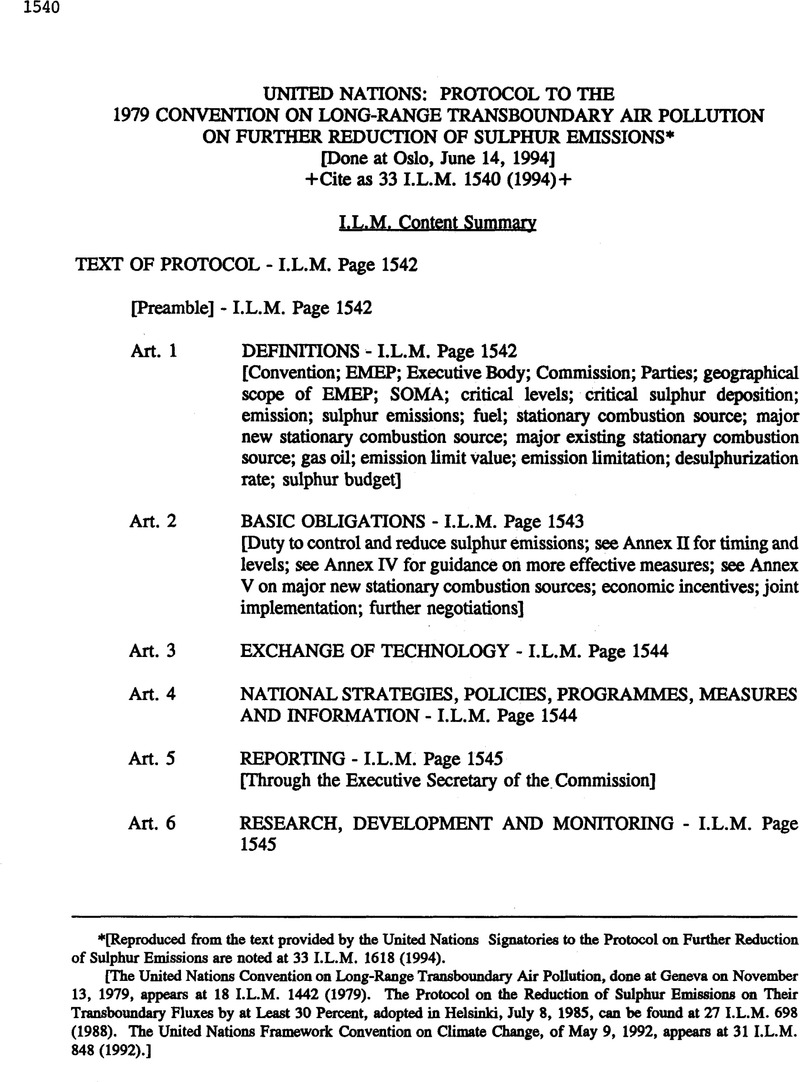Article contents
United Nations: Protocol to the 1979 Convention on Long-Range Transboundary Air Pollution on Further Reductions of Sulphur Emissions
Published online by Cambridge University Press: 18 May 2017
Abstract

- Type
- Treaties and Agreements
- Information
- Copyright
- Copyright © American Society of International Law 1994
Footnotes
[Reproduced from the text provided by the United Nations Signatories to the Protocol on Further Reduction of Sulphur Emissions are noted at 33 I.L.M. 1618 (1994).
[The United Nations Convention on Long-Range Transboundary Air Pollution, done at Geneva on November 13, 1979, appears at 18 I.L.M. 1442 (1979). The Protocol on the Reduction of Sulphur Emissions on Their Transboundary Fluxes by at Least 30 Percent, adopted in Helsinki, July 8, 1985, can be found at 27 I.L.M. 698 (1988). The United Nations Framework Convention on Climate Change, of May 9, 1992, appears at 311.L.M. 848 (1992).]
References
page 1549 note a/ If, in a given year before 2005, a Party finds that, due to a particularly cold winter, a particularly dry summer and an unforeseen short-term loss of capacity in the power supply system, domestically or in a neighbouring country, it cannot comply with its obligations under this annex, it may fulfil those obligations by averaging its national annual sulphur emissions for the year in question, the year preceding that year and the year following it, provided that the emission level in any single year is not more than 20% above the sulphur emission ceiling. The reason for exceedance in any given year and the method by which the three-year average figure will be achieved, shall be reported to the Implementation Committee.
page 1549 note b/ For Greece and Portugal percentage emission reductions given are based on the sulphur emission ceilings indicated for the year 2000.
page 1549 note c/ European part within the EMEP area.
page 526 note * Options (i) (a) and (b) are integrated in the energy structure and policy of a Party. Implementation status, efficiency and costs per sector are not considered here.
page 1552 note a/ For high sulphur content in the fuel the removal efficiency has to be adapted- However, the scope for doing so may be process-specific. Availability of these processes is usually 95%.
page 1552 note b/ Limited applicability for high-sulphur fuels.
page 526 note c/ Emission in mg/m3 (STP), dry, 6% oxygen for solid fuels, 3% oxygen for liquid fuels.
page 1552 note d/ Conversion factor depends on fuel properties, specific fuel gas volume and thermal efficiency of boiler (conversion factors (m3/kWh,1, thermal efficiency: 36%) used: hard coal: 3.50; brown coal: 4.20; heavy oil: 2.SO).
page 1552 note e/ Specific investment cost relates to a small sample of installations.
page 1552 note f/ Specific investment cost includes denitrification process. The table was established mainly for large combustion installations in the public sector. However, the control options are also valid for other sectors with similar exhaust gases.
page 1553 note **/ Control of sulphur-to-sodium ratio is required, i.e. removal of sulphur in the form of neutral salts and use of sulphur-free sodium make-up.
page 1555 note a/ As guidance, for a plant with a multi-fuel firing unit involving the simultaneous use of two or more types of fuels, the competent authorities shall set emission limit values taking into account the emission limit values from column (ii) relevant for each individual fuel, the rate of thermal input delivered by each fuel and. for refineries, the relevant specific characteristics of the plant. For refineries, such a combined limit value shall under no circumstances exceed 1700 mg SO2/Nm3. In particular, the limit values shall not apply to the following plants: Plants in which the products of combustion are used for direct heating, drying, or any other treatment of objects or materials, e.g. reheating furnaces, furnaces for heat treatment;
page 1555 note b/ mg SO2/Nm3 is defined at a temperature of 273° K and a pressure of 101.3 kPa, after correction for the water vapour content.
- 2
- Cited by


